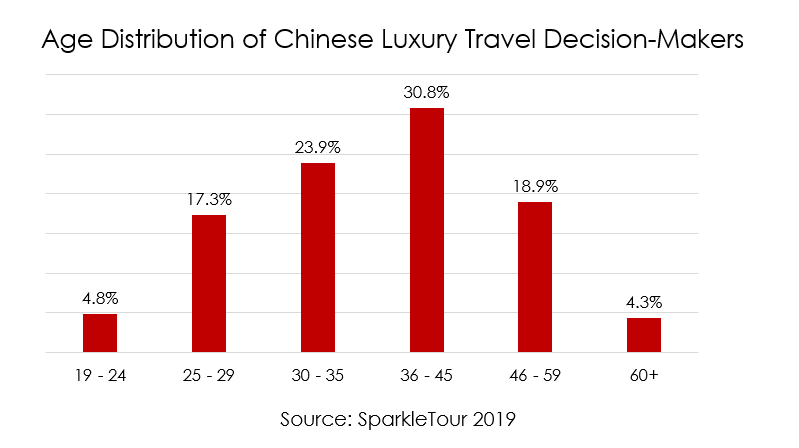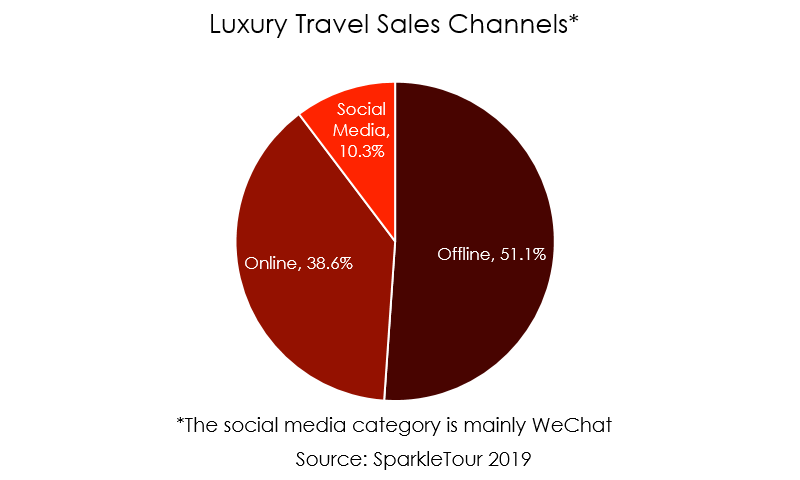A new report from Chinese luxury travel agency SparkleTour identifies the main keywords and trends in the development of high-end Chinese tourism. We’ve translated the report to give you insights on the demographics, sales channels, destinations, and other trends in Chinese luxury travel consumption. You can access the original report (in Chinese) here.
Keyword 1: Post-90s Consumerism
The proportion of travel decision makers aged 19-29 reached 22.1%, a significant increase compared to previous years.
In their hotel choices, Chinese luxury travelers born in the 1990s show a preference for novel experiences, including newly opened hotels and higher-grade rooms.

Keyword 2: Female Decision-Makers
Women account for at least 53.2% of decision-makers for high-end tourism consumption.
Travel consumption is a major expenditure for high net worth (HNW) Chinese, and the main decision makers and consumers for tourism are women. They hold more decision-making power in the choice of travel destinations, travel planning and spending, so it is of great significance to understand the consumption preference and communication focus of women in HNW households, and use this to inform the promotion strategy for destinations and tourism services.

Keyword 3: WeChat Marketing
During the 11/11 shopping holiday, the proportion of high-end travel sales on Tmall and other traditional e-commerce platforms declined in 2018, compared to 2017. At the same time, there was a noticeable increase in high-end travel purchases directly through WeChat. WeChat-related purchase support functions are becoming more and more comprehensive, and many small and medium-sized brands find that WeChat is now one of their main sources of traffic.

Trend 1: Adventure and Long-Distance Travel
According to SparkleTour’s data, the top five destinations for high-end tourists in the past two years are: Europe (18%), and the Americas (17%), with Japan and South Korea, and Southeast Asia and the Indian Ocean both with (10%). The South Pacific Islands (9%) and the Middle East and Africa (6%) rose fastest in the top five. Tahiti and Fiji are leading high-end travel in the South Pacific, while growth to Southeast and South Asia has been almost flat.
High-end travelers have a strong willingness to travel to the Arctic, Antarctica and South America.
Trend 2: High-End Tourism Shifting to New Products
High-end travel styles are no longer confined to traditional elements such as business class or five-star hotels, and luxury travelers are increasing their awareness of and interest in river cruises and luxury sightseeing trains.
Trend 3: Consumers in Second-Tier and Third-Tier Cities Growing Rapidly
As more and more tourists pursue high quality, differentiation and personalization on their travels, recognition and enjoyment of high-end travel services is increasing among HNW people outside of China’s first-tier cities.
A high concentration of HNW consumers can be found in the cities of Hangzhou and Chengdu. High-end tourists in second-tier cities have a strong willingness to travel, which means these source markets are expected to grow faster in the future.
Trend 4: Increasing Trip Length and Depth
The proportion of tourists going on long trips of 7 days or more reached 55.6%. Those traveling for 15 days and more reached 6.5%.
High-end consumers prefer in-depth travel experiences, they are more flexible, and they have more time to travel. Trips of over one week are preferred, and high net worth travelers are no longer content to quickly visit and photograph the major sites. Therefore, high-end travel products that can offer special and/or unusual experiences are now more competitive.
Sign up for our free newsletter to keep up to date on our latest news
We do not share your details with any third parties. View our privacy policy.
This website or its third party tools use cookies, which are necessary to its functioning and required to achieve the purposes illustrated in the cookie policy. If you want to know more or withdraw your consent to all or some of the cookies, please refer to the cookie policy. By closing this banner, scrolling this page, clicking a link or continuing to browse otherwise, you agree to the use of cookies.